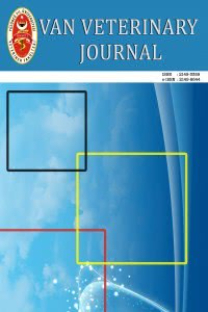Van Et ve Balık kurumu’nda kesilen kıl keçilerinde Linguatula serrata (Fröhlich, 1789) nimflerinin araştırılması
Bu araştırma, Van Et ve Balık Kurumu’nda kesilen kıl keçilerinin mezenteriyal lenf yumrularında Linguatula serrata nimflerinin yaygınlığını ve enfekte lenf yumrularındaki histopatolojik değişiklikleri araştırmak için yapılmıştır. Bu amaçla, 116 keçinin mezenteriyal lenf yumrusu incelenmiş, 9 keçide (%7.76) L. serrata nimfi tespit edilmiştir. Enfekte keçilerde toplam 9 adet L. serrata nimfi toplanmış olup, her mezenteriyal lenf yumrusunda birer adet L. serrata nimfi görülmüştür. Enfekte mezenteriyal lenf yumrularının histopatolojik incelenmesinde, içerisinde nimfin yer aldığı kistik yapının yangısal bir alanla çevrelendiği, lenfoid folliküllerde ise lenfositlerin azalmasına bağlı olarak lenfoid folliküllerinin merkezinin boşaldığı tespit edilmiştir.
Anahtar Kelimeler:
kıl keçisi, histopatoloji, lenf, parazitler, keçi, hastalık yaygınlığı, Türkiye, Linguatula serrata
Investigation of Linguatula serrata nymphs (Fröhlich, 1789) in hair goats slaughtered in Van Meat and Fish institution combine
This study was carried out to study the prevalence of Linguatula serrata nymphs and histopathologic examination of infected the mesenteric lymph nodes of hair goats slaughtered in Van Meat and Fish Institution Combine. For this purpose, mesenteric lymph nodes of total of 116 hair goats were investigated and L. serrata nymphs were detected in 9 hair goats (7.76%). On the other hand, one L. serrata nymph was seen in every mesenteric lymph node. The histopathological examination of the infected mesenteric lymph nodes was demonstrated that cyst formation was encircled with an inflammatory zone and lymphoid depletion of the center of lymphoid follicles is occured depends on lymphocytes decreasing.
Keywords:
hair goat, histopathology, lymph, parasites, goats, disease prevalence, Turkey, Linguatula serrata,
___
- Aldemir OS (2004a). Kars ili kasaplık koyunlarında Linguatula serrata (Fröhlich, 1789) nimf’inin yayılışı. Kafkas Üniv Vet Fak Derg, 10, 135-137.
- Aldemir OS (2004b). Erzurum yöresi sokak köpeklerinde Linguatula serrata’nın yayılışı. Türkiye Parazitol Derg, 28, 42-44.
- Aydenizöz M, Güçlü F (1997). Konya yöresinde Linguatula serrata (Fröhlich, 1789)’nın yayılışı. Türkiye Parazitol Derg, 21, 75-78.
- Dinçer Ş (1983). Elazığ mezbahasında kesilen hayvanlarda ve sokak köpeklerinde Linguatula serrata (Fröhlich, 1789)’nın yayılışı ve halk sağlığı açısından önemi. Ankara Üniv Vet Fak Derg, 29, 652-656.
- Georgi JY (1994). Parasitology for Veterinarians. Thirt Edition. W.B. Saunders Company. Philedelphia, London, Toronto.
- Güçlü F, Aydenizöz M (1995). Konya’da köpeklerde dışkı bakılarına göre parazitlerin yayılışı. Türkiye Parazitol Derg, 19, 550-556.
- Gürler AT, Doğanay A (2007). Ankara civarında bulunan tavşanlarda solunum ve sindirim sistemi helmintlerinin yaygınlığı. Ankara Üniv Vet Fak Derg, 54, 105-109.
- Haralabidis ST, Papazachariadou MG, Koutinas AF, Rallis TS (1988). A survey on the prevalence of gastrointestinal parasites of dogs in the area of Thessaloniki, Greece. J Helminthol, 62, 45-49.
- İşler O, Tınar R (1993). Bir insanın koledok kanalında Linguatula serrata (Fröhlich, 1789) nimfi. Türkiye Parazitol Derg, 17, 108-111.
- Lazo RF, Hidalgo E, Lazo JE et al. (1999). Ocular linguatuliasis in Ecuador: case report and morphometic study of the larva of Linguatula serrata. Am J Trop Med Hyg, 60, 405-409.
- Luna LN (1968). Manuel of histologic staining methods of the Armed Forces Institute of Pathology. 3rd Ed., McGraw-Hill, New York.
- Maleky F (2001). A case report of Linguatula serrata in human throat from Tehran, Central Iran. Indian J Med Sci, 55, 439-441.
- Meshgi B, Asgarian O (2003). Prevalence of Linguatula serrata infection in stray dogs of Shahrekord, Iran. J Vet Med, 50, 466-467.
- Miclaus V, Mihalca AD, Negrea O, Oana L (2008). Histological evidence for inoculative action of immature Linguatula serrata in lymph nodes of intermediate host. Parasitol Res, 102, 1385-1387.
- Morsy TA, El-Sharkawy IM, Lashin AH (1999). Human nasopharyngeal linguatuliasis (Pentasomida) caused by Linguatula serrata. J Egypt Soc Parasitol, 29, 787-790.
- Pandey VS, Dakkak A, Elmamoune M (1987). Parasites of stray dogs in the Rabat region, Morocco. Ann Trop Med Parasitol, 81, 53-55.
- Ravindan R, Lakshmanan B, Ravishankar C, Subramanian H (2008). Prevalence of Linguatula serrata in domestic ruminants in South India. Southeast Asian J Trop Med Publ Health, 39, 808-812.
- Saiyari M, Mohammadian B, Sharma RN (1996). Linguatula serrata (Frölich, 1789) nymphs in lungs of goats in Iran. Trop Anim Health Prod, 28, 312-314.
- Shakerian A, Shekarforoush SS, Ghafari Rad H (2008). Prevalance of Linguatula serrata nymphs in one-humped camel (Camelus dromedarius) in Najaf-Abad, Iran. Res Vet Sci, 84, 243-245.
- Sivakumar P, Sankar M, Nambi PA, Pravena PE, Singh N (2005). The occurrrence of nymphal stage of Linguatula serrata in water buffaloes (Bubalus bubalis): Nymphal morphometry and Lymph node pathology. J Vet Med A, 52, 506-509.
- Soulsby EJL (1987). Helminths, Arthropods and Protozoa of Domesticated Animals. Sixth Edition. Published in the United States by The Williams & Wilkins Company, Baltimore.
- Tajik H, Tavassoli M, Dalirnaghadeh B, Danehloipour M (2006). Mesenteric lymph nodes infectıon with Linguatula serrata nymphs in cattle. Iranian J Vet Res, 7, 82-85.
- Yagi H, El Bahari S, Mohamed HA et al. (1996). The Marrara syndrome: A hypersensitivity reaction of the upper respiratory tract and buccopharyngeal mucosa to nymphs of Linguatula serrata. Acta Trop, 62, 127-134.
- ISSN: 1017-8422
- Yayın Aralığı: Yılda 3 Sayı
- Başlangıç: 1990
- Yayıncı: Yüzüncü Yıl Üniv. Veteriner Fak.
Sayıdaki Diğer Makaleler
Van’da evcil güvercinlerde (Columba livia domestica) coccidia ve helmint türlerinin yayılışı
ABDURRAHMAN GÜL, NALAN ÖZDAL, MUSTAFA SERDAR DEĞER, VURAL DENİZHAN
Kedi ve köpeklerde kardiyovasküler Hastalıkların tanısında Natriüretik peptidler’in önemi
Hasan İÇEN, ÖZGÜR YAŞAR ÇELİK, AYNUR ŞİMŞEK
LOĞMAN ASLAN, Özdemir ADIZEL, ABDULLAH KARASU, CUMALİ ÖZKAN, Musa GENÇCELEP, Atilla DURMUŞ, Yakup AKGÜL
Gıdalarda hareketli Aeromonas’lardan kaynaklanan sağlık riskleri
